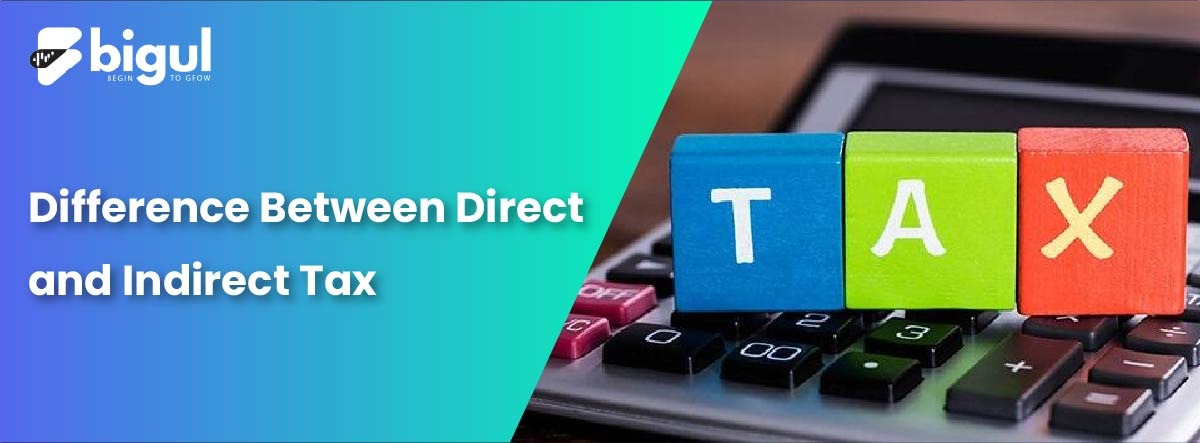In India, taxation is integral to financial responsibilities, impacting both individuals and corporate entities. This obligatory recurring fee, paid to central and state governments, is the primary revenue source to sustain the nation’s economy.
Two fundamental tax categories, direct and indirect taxes, play distinctive roles in this fiscal landscape. While both contribute to government revenue, they do so through varying mechanisms and have distinct impacts on individuals and businesses.
This article dives into the disparities between direct and indirect taxes, highlighting their distinct characteristics and implications for taxpayers.
What is Direct Tax?
Direct taxes, guided by the principle of an individual’s ability to pay, enforce higher tax rates on those with greater resources and income, functioning as a wealth redistribution. These non-transferrable taxes, with individuals and companies solely responsible for their payment. Failure to meet tax obligations can result in fines and legal consequences.
However, the bracket-based direct taxation system may inadvertently discourage higher earners’ productivity, as the prospect of increased taxes may lead to income-capping strategies.
Now, let’s find out different types of direct taxes.
Types of Direct Tax
Direct taxes on persons or companies in India are usually based on income or wealth. India has many direct taxes:
- Income Tax: Income Tax is a significant direct tax levied on individuals, companies, and entities. Governed by the Income Tax Act, it applies to various income sources and is categorized into different heads. Tax rates vary based on income levels and the nature of earnings. Compliance with income tax regulations is essential for all taxpayers in India.
- Corporate Tax: Corporate tax is levied on a company’s income. Rates vary based on turnover and size. Governed by annual Finance Acts, it’s a vital source of government revenue. Companies pay taxes on their profits, ensuring they contribute to public finances while facilitating economic growth and development.
- Capital Gains Tax: India imposes capital gains tax on profits from selling assets like real estate and investments. It categorizes gains as short-term or long-term based on the holding period, with different tax rates for each. This tax encourages responsible investment and affects individuals and entities involved in asset transactions.
- Wealth Tax (Abolished): Wealth Tax was a direct tax imposed in India on an individual’s net wealth, including property, jewellery, and other valuable possessions. It aimed to redistribute wealth by taxing the accumulated assets of affluent individuals. However, the Wealth Tax was abolished in the Finance Act 2015, as it was deemed ineffective and cumbersome. Since then, India no longer levies Wealth Tax, simplifying the tax system and reducing compliance burdens on taxpayers.
- Gift Tax: The Gift Tax Act of 1958 mandated individuals to pay a 30% tax on received gifts, including valuables or money. However, this tax was discontinued in 1998. Originally, gifts like shares, jewellery, and property were taxable. Under new rules, gifts from immediate family members (parents, spouses, uncles, aunts, sisters, and brothers) and local authorities are exempt from taxation. Gifts from others exceeding Rs 50,000 in value are taxable, except from those exempted entities. In such cases, the entire gift amount is subject to tax.
- Expenditure Tax (Repealed): The Expenditure Tax Act, repealed in 1987, was a direct tax in India. It imposed a tax on certain expenditures incurred by individuals and entities while staying at luxury hotels and eating in high-end restaurants. The tax aimed to discourage lavish spending and promote fiscal discipline among affluent individuals. However, due to administrative complexities and limited revenue generation, it was eventually repealed, and its provisions were integrated into the Income Tax Act 1961. This changes consolidated expenditure taxation within the broader framework of income tax regulations.
Benefits of Direct Taxes
Direct taxes assist governments and economies. These benefits pay public services, stabilise the economy, and distribute taxes fairly.
Direct taxes have these benefits:
- Revenue Generation: Direct taxes, such as income tax and corporate tax, serve as a critical revenue source for the Indian government. They consistently generate funds necessary for financing public services and development projects. This revenue stability enables the government to meet its financial obligations, provide essential services, and contribute to economic growth while reducing reliance on volatile revenue sources like indirect taxes.
- Fiscal Discipline: Direct taxes promote fiscal discipline by necessitating accurate income reporting and tax payment. This discourages tax evasion and promotes financial transparency. Taxpayers must disclose their income truthfully, reducing opportunities for fraud and undeclared income. Effective tax administration and compliance enforcement are essential in upholding this discipline. This ensures that individuals and businesses fulfil their tax obligations honestly and contribute to the nation’s revenue, ultimately aiding economic stability and development.
- Progressive Taxation: Progressive taxation ensures that individuals pay a larger proportion of their earnings in taxes. This system promotes income equality by shifting the tax burden towards the affluent, allowing for the redistribution of wealth. It helps fund essential government services and social programs, benefiting the broader population. Progressive taxation aligns with principles of fairness and social responsibility, making it a crucial element of direct taxes for taxpayers and society as a whole.
- Legal Compliance: Paying direct taxes is a legal obligation, ensuring individuals and businesses follow tax laws. Compliance helps avoid legal troubles, penalties, and fines. It promotes a sense of social responsibility and contributes to a functioning society where everyone plays a fair part in funding government operations and public services. By adhering to tax regulations, taxpayers maintain their legal standing and avoid the potential consequences of tax evasion or fraud, which can be detrimental to personal and financial well-being.
- Investment in Infrastructure: Direct taxes play a critical role in financing infrastructure development. When taxpayers pay their taxes, governments have the funds to improve essential infrastructure. This infrastructure, in turn, boosts economic productivity by facilitating smoother transportation and promoting business growth. When businesses thrive and new opportunities emerge, job creation and economic stability can be created. This ultimately benefits taxpayers by providing a more prosperous environment for personal and professional endeavours.
What is Indirect Tax?
Manufacturing, selling, and consuming goods and services incur indirect taxes. Consumers pay these taxes through product prices. Indirect taxes are often called consumption taxes because they are paid when people or corporations buy goods. Indirect taxes are collected by enterprises and returned to the government, unlike direct taxes.
Types of Indirect Taxes
The primary types of indirect taxes in India are:
- Goods and Services Tax (GST): The GST replaces several indirect taxes in India. GST is collected at each level of the supply chain, including manufacturing, sale, and consumption. It contains CGST for the central government and SGST or UTGST for state and union territory governments. This destination-based tax ensures seamless credit flow and has simplified India’s tax structure by unifying various indirect taxes into a single, transparent system.
- Service Tax: Service Tax was a consumption-based indirect tax in India imposed on specified services provided within the country. It included banking, insurance, telecommunications, and more when it was launched in 1994. Service providers collected and sent this levy to the government. Service Tax was merged into the Goods and Services Tax (GST) in 2017, simplifying the tax structure and promoting uniformity between states and services.
- Value Added Tax (VAT): Value Added Tax (VAT) is a widespread form of indirect taxation. It’s applied at different stages of the production and distribution of goods and services but doesn’t burden businesses directly. Instead, they collect VAT from customers during sales transactions and then remit it to the government. Businesses can typically offset the VAT they paid on their inputs with the VAT they collect on sales, ensuring that the final consumer bears the tax burden. VAT is a crucial revenue source for governments worldwide and is known for its cascading effect on prices throughout the supply chain.
- Central Sales Tax (CST): Central Sales Tax was imposed on the sale of goods during inter-state trade and commerce in India. It was collected by the central government but distributed to the state where the goods were consumed. CST aimed to prevent double taxation in the sale of goods across state borders. However, after GST was implemented in 2017, CST was replaced by the Integrated Goods and Services Tax (IGST) to create a unified and simpler taxation structure for inter-state transactions.
- Customs Duty: Customs Duty in India is a tax imposed on importing and exporting goods. It consists of several components: basic customs duty, additional customs duty (Countervailing Duty or CVD), and special additional duty. These duties are collected by the Customs Department at the country’s borders. Basic customs duty is levied on the assessed value of imported goods, while CVD is imposed to counteract the impact of excise duties on domestically produced goods. Special additional duty is applied to safeguard the interests of domestic industries. Customs duties are crucial for regulating trade and generating revenue for the government.
- Entertainment Tax: Entertainment Tax is a state-level tax imposed on activities like movie screenings, amusement parks, and live performances in India. State governments collect it and contribute to their revenue. This tax aims to generate income from entertainment-related events and services, with the rates and rules varying from one state to another. It adds to the cost of such entertainment for consumers and helps finance state expenditures.
- Entry Tax: Entry Tax is a state-level indirect tax in India. It is imposed on goods entering a state from another state. The purpose is to protect local industries and generate revenue for the state government. The tax rate and items subject to entry tax can vary from state to state. It is collected at state borders or entry points and adds to the cost of goods outside the state. Entry Tax was significant before the implementation of GST but has become less relevant due to the unified tax structure.
Benefits of Indirect Tax
Indirect taxes have several benefits for governments and can impact individuals and businesses in various ways.
Some of the key benefits of indirect taxes are:
- Broad-Based Revenue Source: Indirect taxes in India are levied on a wide range of goods and services. This includes essentials and luxury items to create a broad-based revenue source for the government. This diversity in taxable items ensures a stable income stream, reducing the government’s reliance on a single sector or income group. It provides fiscal resilience and helps maintain government functions and public services, even during economic fluctuations, making it a crucial aspect of India’s taxation system.
- Easier to Administer: Indirect taxes are administratively efficient as they are collected at various points in the supply chain. This simplifies tax collection and reduces administrative burdens. Businesses collect and remit these taxes, making it easier for authorities to monitor compliance. This efficiency translates to lower administrative costs for both the government and taxpayers, as the process involves fewer complex assessments and audits compared to the administration of direct taxes, like income tax, which require extensive income verification and enforcement efforts.
- Reduced Tax Evasion: Indirect taxes, collected at multiple stages of production and distribution, reduce tax evasion. Businesses and individuals find it challenging to evade taxes because the tax liability is embedded in the price of goods and services. This reduces the incentive for underreporting income or engaging in tax evasion schemes. As a result, governments can collect more reliable revenue, promoting fairness in the tax system and ensuring that everyone pays their fair share, ultimately benefiting the overall economy.
- Encourages Savings and Investments: Indirect taxes, by taxing consumption rather than income, encourage people to save and invest their money. This occurs because individuals who spend less on taxed goods and services can potentially allocate more of their income to savings and investments, fostering economic growth and financial security in the long run. This indirect tax structure promotes financial prudence and responsible fiscal behaviour among citizens.
- Stability of Revenue: Indirect taxes provide stability in government revenue. These taxes are less influenced by economic fluctuations than direct taxes, such as income tax. This stability ensures a predictable income source for the government, enabling better fiscal planning and budgeting. It also reduces the government’s reliance on volatile income-related tax revenue, which can fluctuate with economic cycles. This can ultimately contribute to overall fiscal stability and responsible financial management.
Difference Between Direct and Indirect Tax
The classification of taxes is primarily based on the entity responsible for collecting taxes from taxpayers. Below is a summary highlighting the distinctions between direct and indirect taxes:
| Aspect | Direct Tax | Indirect Tax |
| Definition | Taxes directly imposed on individuals or entities based on their income, wealth, or profits. | Taxes levied on the purchase, consumption, or use of goods and services. |
| Incidence | A taxpayer cannot shift the tax burden to someone else. | The tax load can be moved from the original payer (like businesses) to the final consumer. |
| Examples | Income tax, corporate tax, property tax. | GST and Customs duty |
| Impact on Behavior | May affect savings, investment, and work effort. | Can influence consumption choices. |
| Progressivity | Can be progressive (higher income, higher tax rate) or flat. | Often regressive (same rate for all income levels), but differ from industry to industry. |
| Collection | Typically collected directly by tax authorities from taxpayers. | Collected by businesses from consumers and remitted to tax authorities. |
Disadvantages of Direct and Indirect Taxes
Direct and indirect taxes both have their advantages and disadvantages in India, and they impact individuals and businesses differently.
Disadvantages of Direct taxes in India:
- Economic Distortion: Direct taxes can lead to economic distortions as they may discourage savings and investments, potentially hindering economic growth.
- Compliance Burden: The complex nature of direct tax laws can place a heavy compliance burden on taxpayers, especially small businesses and individuals.
- Tax Evasion: High direct tax rates can encourage tax evasion, leading to a loss of government revenue and reduced fairness in the tax system.
- Impact on Middle-Income Earners: Direct taxes often affect middle-income earners disproportionately, as they may have fewer opportunities for tax planning compared to high-income individuals.
Disadvantages of Indirect taxes in India:
- Regressiveness:Indirect taxes, such as the Goods and Services Tax (GST) in India, tend to be regressive, meaning they place a higher relative burden on low-income individuals. Basic necessities are also subject to taxation, affecting the poor disproportionately.
- Complexity:India’s indirect tax system can be complex, with multiple tax rates, exemptions, and compliance requirements. This complexity can create administrative challenges for businesses and increase compliance costs.
- Cascading Effect:The cascading effect of taxes occurs when taxes are levied on top of taxes throughout the production and distribution chain, leading to higher prices for consumers and reduced competitiveness for businesses.
Direct and indirect taxes, collected by central and state governments based on tax types, are vital for government revenue and the nation’s economic health, forming a crucial link between fiscal policy and financial stability.
Why is GST an Indirect Tax?
On July 1, 2017, India implemented the GST to streamline and consolidate various indirect taxes, eliminating the cascading effect of taxation. This tax reform replaced compulsory state-level taxes such as service taxes, state excise duties, countervailing duties, additional excise duties, and additional customs duties.
At the central level, GST subsumed taxes like sales, central sales, purchase, entertainment, luxury, octroi, entry, betting, and lottery taxes. In total, GST unified 17 indirect taxes, encompassing a wide range of goods and services, providing consumers relief from multiple layers of taxation.
Conclusion
Understanding the difference between direct and indirect taxes is crucial for anyone managing their finances or studying economics. Direct tax is taken immediately from your earnings, whereas indirect tax is collected when you shop.
Indirect taxes are buried in product prices and affect everyone equally, while direct taxes are more evident and progressive, affecting income differently. Both types of taxes play vital roles in funding government activities and services, making them essential aspects of our economic landscape.
FAQs
- How does the impact of direct and indirect taxes differ?
Direct taxes tend to be more progressive, affecting individuals based on income or assets. Indirect taxes are regressive, as they apply uniformly regardless of income, often impacting lower-income individuals more significantly.
- Which type of tax is easier to administer, direct or indirect?
Indirect taxes are generally easier to administer because they rely on a straightforward collection system through intermediaries like businesses. Direct taxes involve complex assessment and verification processes.
- Are there instances where a tax can be both direct and indirect?
No, a tax is either direct or indirect, not both. The classification depends on how it’s collected and who bears the ultimate economic burden.
- How can understanding the difference between these taxes benefit individuals and businesses?
Understanding these distinctions helps individuals and businesses make informed financial decisions. It allows for better tax planning and compliance, ultimately affecting financial well-being.
- Does GST fall under the direct or indirect tax category?
GST falls under the category of indirect taxes. It’s a consumption-based tax levied on the supply of goods and services collected by businesses and paid by consumers when they make purchases.
- What type of tax is property tax?
Property tax is a local tax imposed on the assessed value of real estate properties, including land and buildings. It is a form of ad valorem tax, meaning it is based on the property’s value, and the revenue generated typically funds local government services and infrastructure.

.jpg)






.jpg)
.jpg)
